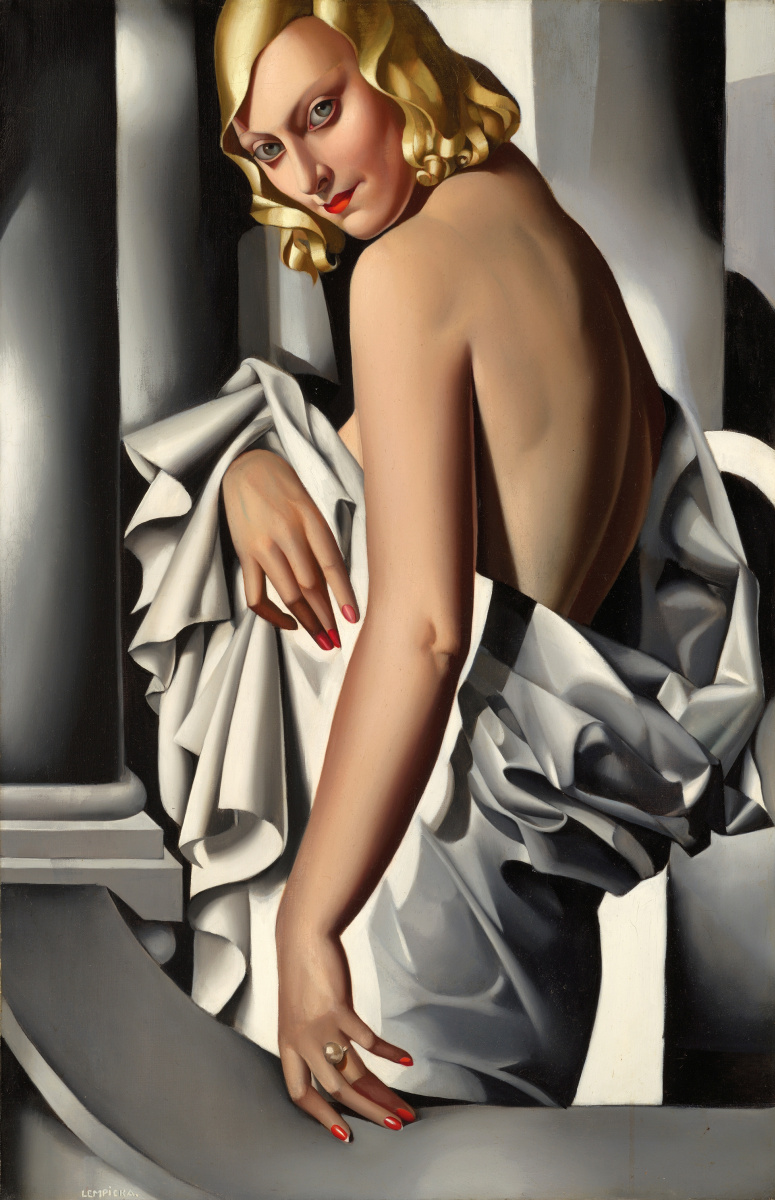Portrait of Marjorie Ferry
Description of the artwork «Portrait of Marjorie Ferry»
The young woman, who is walking along the marble balcony, looks seductive, but at the same time she is chastely wrapped in a satin sheet. She could have been an actress who made a dizzying debut in Hollywood's Golden Age - an aspiring blonde goddess who defied Greta Garbo, Gene Harlow or Carol Lombard. Marjorie Ferry was indeed an artist, accustomed to the light of the ramp, namely, the British cabaret singer, who performed in Paris. Having met a wealthy financier, she became his wife. The newlywed gave her a ring with a bright large cabochon and the opportunity to perpetuate the jewel in the portrait, which he ordered in 1932 from the most fashionable and sought-after of Parisian portrait painters of that time - Tamara de Lempitskaya. Just a few years before, the Polish artist, known for her sensual nudes, became the most noticeable woman among the leading modernist painters.
Lempicka, who became famous as a socialite, was at the peak of fame in the early 1930s. The professional and social aspects of her life were inextricably linked with each other, and a specially equipped art deco studio in Rue Meschen, 7, in the 14th arrondissement of Paris, became the center of attraction. She led her own independent lifestyle, which was then a relatively rare achievement for a woman.
After a short trip to New York in late 1929 and early 1930, Lempicka became the first portrait painter, sought after by wealthy Europeans as well as among Americans who followed modernism, which dominates international post-war art. She could accept orders or refuse them when she saw fit. Lempitskaya’s international customer base was wider than her main competitor Kesa Van Dongen. Although he had a more ardent and reckless approach to work, he lacked American ties.
Since the late 1920s, Lempicka has painted in her signature high classic style, which manifests itself in all aspects of this boldly conceived "Portrait of Marjorie Ferry." The situation on it is most likely imaginary, as if it were the scenery for a film about Ancient Greece. In the Lempicki concept, a polished curved stone balustrade and four ascending columns pick up her model and ascend to the height of Olympus, from where Marjorie Ferry looks at the world. The artist’s decision to cut off the top of the model is a cinematic move, but a bold and infrequent reception in portraiture; thus, the viewer perceives the woman higher. The thoroughness with which Lempicka performed the drapery is also a direct reference to the ancient Greek classics.
Combining the stylistic features of French cubism, post-war purism and neoclassicism with her studies of early Italian masters and demonstrating an understanding of modern realistic trends in Germany, Lempicka created her own boldly cosmopolitan and classical style. She drew inspiration from Engrawhose exemplary classicism of the mid-19th century promptedPicasso return to figurative painting after the First World War.
Lempicka wrote Marjorie Ferry at a crucial stage in her career, amid events that happened three years earlier. In October 1929, nine days after her arrival in New York, the Wall Street stock market crashed. The bank went bankrupt and closed, where the artist contributed a significant amount. They saved her orders, which Lempicki received thanks to her business acumen (she claimed that by the age of 28 she became a millionaire) - the artist was able to "land on her feet" in situations that could be fatal to her colleagues.
The Paris art market was largely supported by wealthy American tourists and US citizens temporarily living in France. As the crisis developed, they began to return home. Dealers stopped buying, reduced prices and replaced personal exhibitions with group exhibitions. Even leading artists suffered - only Picasso, the most famous and richest of them, entrusted his considerable fortune to a reasonable banker and comfortably survived the financial chaos.
By all accounts, 1932 was an exceptional year for Lempicki’s career. As the depression deepened, she actually benefited from those who lost the most money, but wanted to show that she was not afraid of economic shocks. Perhaps the patronage of Tamara in the writing of "Portrait of Marjorie Ferry" was provided by Susie Solidor - the new lover of the artist and also a singer from the club. The author included this work in a personal exhibition, which she opened on May 10 in her studio on Meshen Street, and two weeks later sent her to the Tuileries Salon. In October of that year, the canvas was presented at the Galerie Fauvety in a group show, including the work of Picasso.
In 2020, “Portrait of Marjorie Ferry” became the most expensive work in the works of Tamara de Lempicki. At Christie's auction on February 5, he was sold for 16.3 million pounds (21.2 million US dollars).
Author: Vlad Maslov
Read in Arthive:TAmara de Lempicka: Baroness with a tassel


